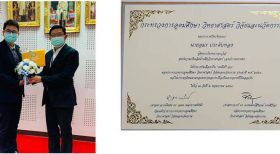Faculty of Science, Kasetsart University houses a variety of instruments that can facilitate a broad range of research, both physical and biological sciences. Research Facilities are divided into the following areas:
Spectroscopy
| 400 MHz Nuclear Magnetic Resonance (NMR) spectrometer |
 |
Model: Bruker AVANCE III HD console
Description: NMR is an important technique for structural determination of compounds and sample used in this technique is non-destructive. Instrument is available at Department of Chemistry and samples can be submitted through the online system. |
| Atomic Absorption Spectrometer (AAS) |
 |
Model: Perkin-Elmer AAnalyst 800 ,Waltham, MA, USA
Description: AAS is an analytical technique for the quantitative determination of chemical elements using the absorption of optical radiation (light) by free atoms in the gaseous state. |
| Spectrofluorometer |
 |
Model: Varian Cary Eclipse, Palo Alto, CA, USA
Description: A spectrofluorometer is an instrument which takes advantage of fluorescent properties of some compounds in order to provide information regarding their concentration and chemical environment in a sample. A certain excitation wavelength is selected, and the emission is observed either at a single wavelength, or a scan is performed to record the intensity versus wavelength, also called an emission spectra. |
| Ultraviolet Spectrophotometer |
 |
Model: Shimadzu UV-1601, Kyoto, Japan
Description: UV Spectrometer is an analytical instrument for the quantitative determination of different analytes, such as transition metal ions, highly conjugated organic compounds, and biological macromolecules. |
Separation Instruments
| Nano Liquid Chromatography(Nano-LC)-Quadrupole Time-of-Flight (QTOF) Mass Spectrometer |
 |
Model: Bruker micrOTOF-Q III, Billerica, MA, USA
Description: Nano-LC attatched with QTOF is one of the most powerful techniques in the field of proteomics. Nano-LC is chromatography with very low flow rates in the nanoliter per minute range and QTOF mass spectrometer is high mass accuracy and high resolution instruments ideal for peptide sequencing in the Information Dependent Acquisition (IDA) mode. Their high resolution is useful for determination of charge state and protein mass measurements in addition to accurate mass determination of biological compounds and chemical synthesis. |
| Gas Chromatography |
 |
Model: Agilent 7890A, Santa Clara, CA, USA
Detector: Flame Ionization Detector (FID), Thermal Conductivity Detector (TCD), Flame Photometric Detector (FPD)
Description: Gas chromatography (GC) is a common type of chromatography used in analytical chemistry for separating and analyzing compounds that can be vaporized without decomposition. |
| High Performance Liquid Chromatography – Mass Spectrometer |
 |
Model: Agilent 1100 series LC/MSD Trap SL, Karlsruhe, Germany
Detector: Diode Array Detector (DAD), ion-trap MS
Description: Liquid chromatography–mass spectrometry (LC-MS, or alternatively HPLC-MS) is an analytical chemistry technique that combines the physical separation capabilities of liquid chromatography (or HPLC) with the mass analysis capabilities of mass spectrometry (MS). |
| High Performance Liquid Chromatography – UV/Fluorescence Detector |
 |
Model: Prostar 210, Santa Clara, CA, USA
Detector: Photodiode Array, Fluorescence Detector
Description: Used frequently in biochemistry and analytical chemistry to separate, identify, and quantify compounds. The system composed of photodiode array detector for complicated analysis at different wavelengths and fluorescence detector for fluorescence compounds. |
| Extraction and Digestion Microwave |
 |
Model: CEM MARS – X, Matthews, NC, USA
Description: This instrument is designed for laboratory use in extracting, digesting, dissolving, hydrolyzing, or drying a wide range of materials. Its primary purpose is the rapid preparation of samples for a variety of analysis procedures including chromatography, liquid absorption spectrometry, inductively coupled plasma atomic emission spectrometry or other analytical techniques.
|
Elemental and material analysis instruments
| Elemental and material analysis instruments |
| Atomic Force Microscope (AFM) |
 |
Model: Asylum Research MFP-3D Bio, Santa Barbara, CA, USA
Description: The Atomic Force Microscope (AFM), has been the instrument of choice for three dimensional measurements for many applications including physics, material science, polymers, chemistry, nanolithography, bioscience, and quantitative nanoscale measurements. |
| Scanning Electron Microscope |
 |
Model: FEI Quanta 450, Hillsboro, OR, USA
Description: A scanning electron microscope (SEM) is a type of electron microscope that produces images of a sample by scanning it with a focused beam of electrons. This model can operate in both high vacuum mode for high resolution and low vacuum mode for non-coating sample like bio-sample. With Energy Dispersive Spectroscopy (EDS), this model can determine the element on the sample as well. |
| X-Ray Diffractometer |
 |
Model: Bruker D8 Advance, Karlsruhe, Germany
Description: X-ray powder diffraction (XRD) is a rapid analytical technique primarily used for phase identification of a crystalline material and can provide information on unit cell dimensions. |
| Micro-Elemental Analyzer |
 |
Model: LECO CHNS-932, St. Joseph, MI, USA
Description: CHNS-932 Elemental Analyzer is capable of determining the amount of carbon, hydrogen, nitrogen and sulfur present in a homogeneous aliquot weighing approximately 0.6–1.6mg (2.0mg maximum). |
| Macro-Elemental Analyzer |
 |
Model: LECO CHN-628, St. Joseph, MI, USA
Description: CHN-628 Elemental Analyzer is capable of determining the amount of carbon, hydrogen, nitrogen and sulfur present in a homogeneous aliquot weighing approximately 100 – 250 mg (250 mg maximum). |
| Coating Material |
 |
Model: Quorum Technology Polaron Range SC7620, Lewes, UK)
Description: This coater can be coated gold on the sample for sample preparation of SEM. |
Biological analysis instruments
| Confocol Microscope |
 |
Model: Nikon Digital Eclipse C2Si, Tokyo, Japan
Description: Confocal microscopy is an optical imaging technique for increasing optical resolution and contrast of a micrograph by means of adding a spatial pinhole placed at the confocal plane of the lens to eliminate out-of-focus light. It enables the reconstruction of three-dimensional structures from the obtained images. |
| Stereofluorescence Microscope |
 |
Model: Olympus SZX16 ,Tokyo, Japan
Description: The SZX16 is designed for advanced research and is suitable for oblique and bright field illumination. Its maximum numerical aperture (NA) of 0.3 produces a resolution of 900 linepairs per millimeter, enabling more sample information to be gained efficiently. The large zoom ratio of 16.4:1, combined with the comprehensive range of parfocal objectives with excellent working distances, allows easy switching between a macro- and micro-view. Imaging of the whole organism down to fine microscopic and individual cell structures becomes an easy task with an optical system that provides a natural, distortion-free view. |
| Imaging Analyzer |
 |
Model: Vilber Lourmat Fusion FX7, Paris, France
Description: Fusion FX7 is an image acquisition system dedicated to the capture of chemiluminescence and fluorescence gel images. |
| Isothermal Titration Calorimeter |
 |
Model: GE Healthcare MicroCalTM iTC200, Piscataway, NJ, USA
Description: Isothermal Titration Calorimetry (ITC) is a technique used in quantitative studies of a wide variety of biomolecular interactions. It works by directly measuring the heat that is either released or absorbed during a biomolecular binding event. |
| Real Time PCR |
 |
Model: Qaigen Rotor Gene Q5 Plex HRM, Valencia, CA, USA
Description: Real time PCR is a technique used to monitor the progress of a PCR reaction in real time. At the same time, a relatively small amount of PCR product (DNA, cDNA or RNA) can be quantified. |
























